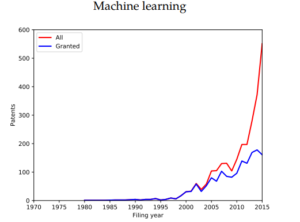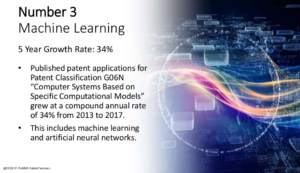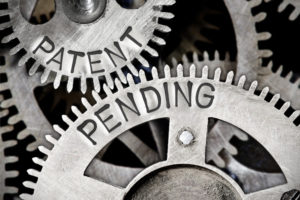
What the ML Patent Application Boom Means for Tech

(Kris Tan/Shutterstock)
There has been a surge in applications of machine learning over the last few years as companies look for ways to leverage big data in their products and services. That has corresponded with a big increase in another type of machine learning application – i.e. those sent to the United States Patent and Trademark Office for protection. But the ramifications of the machine learning-patent uptick are not yet clear.
Statistical and anecdotal evidence suggests we’re in the midst of major upswing in patent protection requests for machine learning inventions. While hard numbers can be tough to come by due to intricacies of the USPTO process (and the fact that it will conceal applications upon request), several researchers have identified what they see as a surge in interest in protecting machine learning products over the past several years.
For example, a recent study by the National Bureau of Economic Research shows that machine learning is working its way into patent filings related to software, cloud computing, and artificial intelligence. Specifically, it found that that patent applications mentioning “machine learning” increased from 145 in 2010 to 594 in 2016, the latest year data is available. Similarly, mentions of neural networks in patent applications increased from 94 in 2010 to 485 in 2016, the paper found.
“Patenting in machine learning has seen exponential growth since 2010, although patenting in neural networks saw a strong burst of activity in the 1990s that has only recently been surpassed,” write the NBER authors, who published their working paper last month.

Patent applications involving machine learning have skyrocketed in recent years (Source: National Bureau of Economic Research July 2018 paper “Some Facts of High-Tech Patenting”)
Another study conducted by IFI Claims Patent Services found that published patent applications for a certain type of patent applications related to computational models (which includes machine learning and neural networks) grew at a 34% compound annual growth rate (CAGR) from 2013 to 2017.
That increase jibes with what patent attorney Lauren Hockett has seen. Hockett, who’s a partner in the San Diego office of intellectual property law firm Knobbe Martens, says there’s been a noticeable uptick in patent business around machine learning lately.
“My practice does involve a large number of machine learning and artificial intelligence patent applications, and that’s really blossomed over the past two to three years,” Hockett says. “Most of the applications I’ve prepared and filed in the machine learning and artificial intelligence space are relatively recent. Most of those are still waiting in line.”
It can take months, if not years, for the USPTO to assign an examiner to judge the merits of a patent. Regardless of what the patent is for, the rules remain the same: the invention must be something new and it must be something that is not obvious.
While data science skills are in high demand by business, the USPTO does have examiners on staff with enough data science knowledge to be able to judge if a machine learning application is new enough or non-obvious enough to warrant patent protection, Hockett says. “So far my experience with examiners in this field is they have been really helpful,” she says.
Nobody knows how the USPTO will rule on the hundreds of patent requests for machine learning and AI inventions made over the past few years. For starters, the Supreme Court’s 2014 ruling in Alice Corporation vs. CLS Bank made it harder to get a patent just because somebody transferred an abstract idea into software code.
Another wildcard in the mix is the impact that open source software will have on the applications. Many of the underlying technologies in machine learning an AI have been open sourced by their creators. From Apache Spark to Scikit-Learn to Google TensorFlow framework, open source plays a critical role in machine learning technology.
However, open source technology cannot be patented as a rule. But that doesn’t mean that people can’t get patent protection for inventions that are built on open source technology or include some open source technology in them, Hockett says. “When we do look into open source code or when we find out that our clients are using open source code, we like to look into those licenses and see what kind of restrictions and permission they come with,” Hockett says.
The patent attorney has worked with individuals who leverage publicly available convolutional neural networks (CNN), such as AlexNet, as part of their creation. There are limits to how far the USPTO will go in granting patent protection in such a case, Hockett says.
“Somebody who comes in later and uses that CNN for classification of an image in some way, well they wouldn’t be able to patent the CNN architecture,” she says. “However, they could seek patent protection over the specific way that they’ve trained it or the specific way that they’re using it or its role in a larger system.”
Another factor at play is the nature of folks requesting patent protection. According to the NBER study, large companies are leading the way in seeking patent protections for machine learning inventions. American tech firms, led by IBM, Microsoft, Google, and HP, have dominated machine learning patent applications. Few Chinese firms so far have sought protection for machine learning inventions, the researchers write, although they admit that the USPTO application request data is somewhat biased towards the United States (each country manages patents in its own way).

IFI found patents requests mentioning ML are growing at a 34% CAGR (Source: IFI Claims Patent Services)
As machine learning and AI patents are granted, it raises the specter of patent litigation. There is some concern that, given the current land grab occurring for machine learning and AI patents, that we could see the same type of range wars breaking out over AI that we saw Apple, Samsung, and Google wage over smartphones in 2000s.
Some see the surge in machine learning patent requests giving big Web firms more ammo to dominate their respective industries. A recent article in Wired took the tech giants to task for talking about desire for open progress on the one hand, but seeking legal protection for their inventions on the other.
While IBM, Google, and Facebook assured the magazine that they would not abuse the patents as it pertains to machine learning and AI, those assurances should be taken with a large grain of salt. “Given the recent history of fights over tech patents,” Wired author Tom Simonite writes, “some researchers still worry the AI patents piling up could be used in ways that could stifle progress.”
Related Items:
Tech Giants Pile Up Machine Learning Patents
What Analytics Says About Patent Trials































